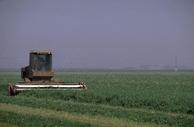|
|
Alfalfa
> Year-Round IPM Program > Spring > Harvest
Timing
 Alfalfa Alfalfa
Harvest Timing
Alfalfa is harvested more frequently in summer and less frequently
in the spring and fall, when growth slows due to cooler weather.
In California, many growers schedule 28-day harvesting schedules
after the first cutting. However, considerable evidence indicates
this might not be ideal. Numerous factors can affect both pest
problems and the yield, quality and profitability of alfalfa,
including harvest timing, cutting height, windrow management,
wheel compaction by harvesting equipment, and border harvesting.
Usually, the choice of harvest time represents a compromise
between the customer’s demand for quality and the grower’s
desire to maintain high yields and a vigorous stand of alfalfa.
The highest quality of alfalfa is low in fiber and high in digestible
protein and total digestible nutrients (TDN). The best time to
harvest alfalfa to maximize quality is during the very young
vegetative stages to early bud stage. However, cutting at these
very early growth stages produces low yields and can greatly
weaken alfalfa stands, since the plant does not have sufficient
time to replenish carbohydrate and protein root reserves. Harvesting
after the plant has replenished root carbohydrate reserves increases
yields and significantly improves health and competitive ability
of the alfalfa stand. The benefits of long cutting schedules
are often carried over from season to season.
Although clear economic incentives exist for growers to produce
early-harvested, high quality forages, repeated early-stage cutting
schedules can be devastating to alfalfa persistence, growth and
yield, and lead to severe weed infestations. Several 'long'
cutting intervals over the year will allow sufficient replenishment
of root reserves, maintain high yields, and provide for
the continued health of the stand. We recommend
that growers consider a ‘staggered’ approach to cutting
schedules. This
involves alternating ‘short’ (26 day)
with ‘long’ (35
day) intervals over the season. Some harvests could be cut early
for quality, and a subsequent harvest would be cut late for high
yields and stand health. Precise cutting schedules are difficult
to recommend because the growth rate of alfalfa depends on location
and time of year.
Early harvest may be a good strategy to avoid further damage
when an alfalfa crop has a high (late) infestation of alfalfa
weevil in the spring, or Lepidoptera (moths and butterflies)
damage in the summer. Early
harvest may also allow you to avoid spraying insecticides. However,
after harvest, growers should monitor fields carefully to detect
early damage to young shoots, which can be devastating to the
following regrowth.
Ideally, the last harvest of the season
should be early enough to allow plants enough time to build up
reserves before the first frost, although this is not critical
in more Southern regions where frosts are later or non-existent.
Sufficient canopy coverage is important to suppress winter weeds.
However, dense winter canopies can lead to high Sclerotinia infestations,
and clipping (even late fall clipping) is an important management
tool when conditions are right for Sclerotinia.
Important links
|


